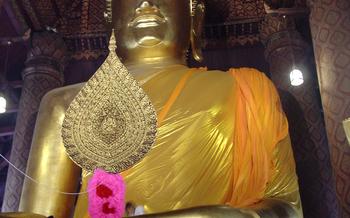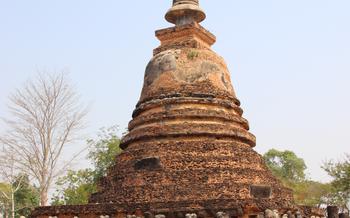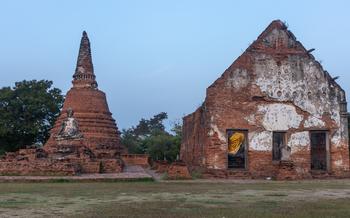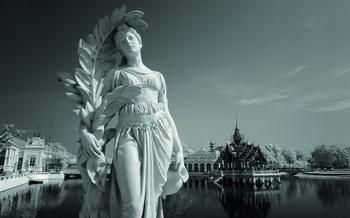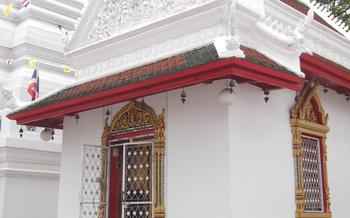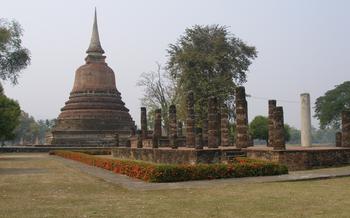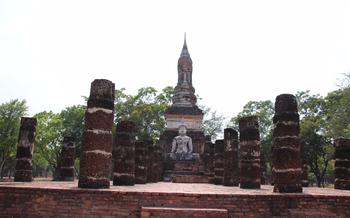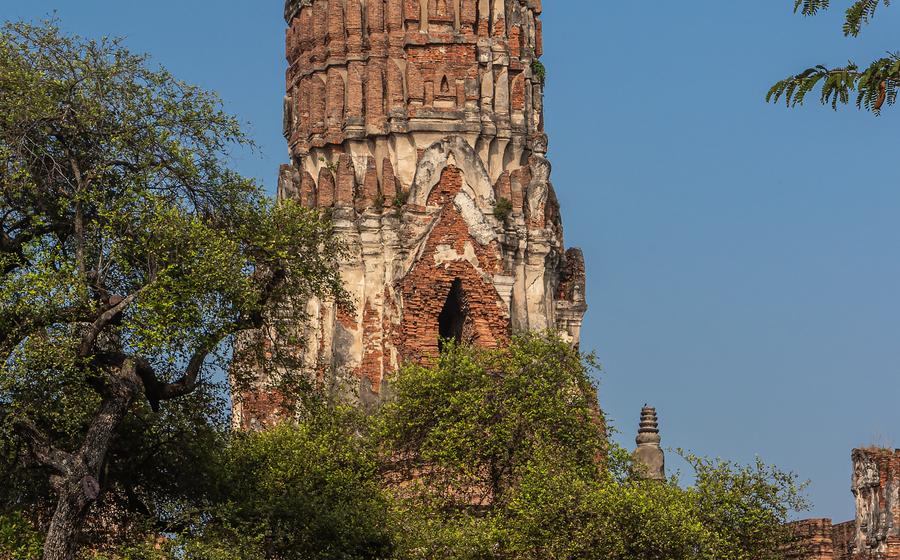
Wat Khun Saen
- Location and Accessibility
- Exploring the Buddha Image at Wat Khun Saen
- Unique Design Elements and Murals
- Practical Information for Visitors
- Walking Around the Temple Grounds
- Photography and Capturing the Beauty
- The Legend of Khun Saen
- Reflections on Wat Khun Saen's Legacy
- Cultural Significance and Festivals
- Local Legends and Beliefs
- Ayutthaya's Historical Context
- Insider Tip: Uncrowded Moments
Location and Accessibility
Wat Khun Saen resides in the heart of Ayutthaya, a city steeped in history and culture. To find this hidden gem, navigate to the Tambon Uthai District, approximately 3 kilometers south of Ayutthaya Historical Park. The temple's seclusion offers a serene escape from the bustling city center.
Reaching Wat Khun Saen is a breeze. Public transportation offers a convenient and affordable option. Hop on a local bus bound for Uthai District and alight at the Wat Khun Saen bus stop.
If you prefer a more personalized experience, rent a bicycle or a motorbike to explore the city's charming streets at your own pace. The ride to the temple takes around 15-20 minutes from the city center.
Private taxis and tuk-tuks are readily available if you seek a hassle-free journey. Simply inform the driver of your destination, and they will navigate the city's intricate roads to deliver you safely to Wat Khun Saen's gates.
To fully immerse yourself in the temple's tranquility, consider visiting early in the morning or late in the afternoon. The soft golden light of these hours casts a magical glow on the temple's architecture, creating an atmosphere of serenity and awe.
While at Wat Khun Saen, don't miss the opportunity to explore nearby attractions. The Ayutthaya Historical Park, a UNESCO World Heritage Site, is a must-visit. Marvel at the majestic ruins of ancient temples and palaces, remnants of Ayutthaya's glorious past.
For a taste of local life, head to the floating market located near the temple. Experience the vibrant colors and lively atmosphere as you browse local delicacies, handicrafts, and souvenirs.
Exploring the Buddha Image at Wat Khun Saen
At the heart of Wat Khun Saen lies an awe-inspiring Buddha image that draws the attention of visitors from all corners of the world. Enshrined within the temple's main hall, this colossal statue exudes an aura of serenity and grandeur. Standing tall at an impressive 16 meters, the Buddha image is a testament to the artistry and devotion that went into its creation.
The image depicts the Buddha in a seated posture, with his right hand raised in the Abhaya mudra, a gesture of reassurance and protection. The intricate details and lifelike features of the statue are truly remarkable, showcasing the exceptional craftsmanship of ancient Thai artisans. The Buddha's serene countenance and gentle smile radiate an atmosphere of peace and tranquility, inviting visitors to contemplate and find solace within the temple walls.
The Buddha image at Wat Khun Saen holds immense religious significance for local Buddhists. It is believed to be one of the oldest and most sacred Buddha images in Ayutthaya, with a history dating back several centuries. Devotees from near and far flock to the temple to pay homage to the revered image, offering prayers, flowers, and incense as a symbol of their devotion.
For visitors, it is important to observe proper temple etiquette while viewing the Buddha image. This includes removing your shoes before entering the temple, dressing modestly, and maintaining a respectful demeanor. Photography is permitted, but be sure to do so discreetly and without using flash, as it may disturb other visitors or interrupt ongoing ceremonies.
Unique Design Elements and Murals
Wat Khun Saen stands out for its striking architectural features and the intricate murals that adorn its walls. The temple's design incorporates elements from both Ayutthaya and Sukhothai architectural styles, creating a visually stunning and harmonious blend. The most notable feature is the large prang (spire) that dominates the temple's skyline. Its graceful curves and intricate decorations are a testament to the skill and artistry of the ancient builders.
The murals that adorn the temple's walls and ceilings are equally impressive. They depict scenes from Buddhist mythology, the life of Buddha, and the epic tale of Khun Saen. The murals are rendered in vibrant colors and feature a variety of characters, including gods, demons, animals, and mythical creatures. The attention to detail and the skillful use of color and composition make these murals a true masterpiece of Thai art.
Each mural tells a story, providing a glimpse into the beliefs and values of the people who created them. Visitors can spend hours exploring the murals, discovering new details and interpretations with each viewing. The murals not only enhance the beauty of the temple but also serve as a valuable source of cultural and historical information.
Practical Information for Visitors
Visiting Wat Khun Saen is free of charge, allowing travelers to explore the temple's wonders without any financial constraints. While guided tours are not typically provided, visitors can immerse themselves in its history and significance through self-guided exploration or by hiring a local guide. To ensure a respectful and harmonious experience, appropriate attire is recommended, with shoulders and knees covered. Visitors should maintain a quiet and contemplative demeanor, mindful of the sacred nature of the temple. Restrooms are available within the temple grounds, providing convenience for visitors.
Walking Around the Temple Grounds
Wat Khun Saen's temple grounds offer a serene and contemplative ambiance, inviting visitors to explore its sacred spaces at a leisurely pace. As you make your way around the temple, take note of the serene Buddha images and intricate wall murals that adorn the buildings. The main ordination hall, or ubosot, is a particularly significant structure, housing the revered Buddha image of Luang Pho Khun Saen.
The temple grounds also feature several smaller shrines and stupas, each with its own unique story to tell. Take the time to wander through the grounds, discovering hidden corners and appreciating the peaceful atmosphere that surrounds you. Remember to be respectful of the temple's sacred nature and maintain a quiet and contemplative demeanor as you explore.
Photography and Capturing the Beauty
Wat Khun Saen's visual splendor and unique architectural features provide ample opportunities for capturing stunning photographs. To make the most of your photography experience, consider the following tips:
-
Best Angles and Spots: The temple's front and side profiles offer captivating perspectives. Position yourself at an angle to capture the full grandeur of the Buddha image and the intricate details of the murals.
-
Lighting Conditions: Visit during the golden hours, just after sunrise or before sunset, to capture the soft, warm light that illuminates the temple and enhances its beauty.
-
Ethical Considerations: Remember that Wat Khun Saen is an active place of worship. Be mindful of ongoing ceremonies and avoid disturbing worshippers. Always ask permission before photographing people.
-
Capturing the Essence: Use a wide-angle lens to capture the vastness of the temple grounds and the surrounding landscape. For close-up shots, focus on specific architectural elements or mural details to convey the temple's intricate craftsmanship.
The Legend of Khun Saen
Wat Khun Saen is closely associated with the legendary warrior and folk hero, Khun Saen. The temple is believed to have been built by Khun Saen himself, who was a skilled swordsman and a powerful warrior. The epic tale of Khun Saen is a beloved story in Thai culture, passed down through generations through oral tradition and literary works.
The legend depicts Khun Saen as a brave and cunning warrior who fought against enemies and protected the kingdom of Ayutthaya. He was known for his magical powers and his ability to transform into various animals. The story of Khun Saen is filled with adventure, romance, and supernatural elements, making it a captivating tale for both locals and foreigners.
Wat Khun Saen plays a significant role in preserving and celebrating the legend of Khun Saen. The temple is home to several murals and paintings that depict scenes from the epic tale, allowing visitors to immerse themselves in the story and learn about the cultural significance of this legendary figure. Local interpretations and variations of the Khun Saen story can be heard from temple guides or local storytellers, providing a deeper understanding of the cultural heritage and folklore surrounding Wat Khun Saen.
Reflections on Wat Khun Saen's Legacy
Wat Khun Saen stands as a testament to the enduring spirit and cultural heritage of the Thai people. Its impact extends far beyond its physical form, deeply woven into the fabric of Thai identity and culture. The temple serves as a symbol of resilience, having withstood the test of time and numerous historical events. Its legacy is one of preservation, showcasing the unwavering dedication to maintaining and honoring Thailand's rich cultural heritage.
For locals, Wat Khun Saen represents a source of pride and a connection to their ancestors. The temple's history and legends have been passed down through generations, creating a profound bond between the community and their sacred site. Visitors to Wat Khun Saen are often struck by its serene atmosphere and the sense of reverence that permeates the grounds. The temple's ability to evoke such emotions speaks to its enduring legacy and the deep spiritual connection it fosters.
Ongoing efforts to preserve and maintain Wat Khun Saen's heritage ensure that future generations can continue to appreciate its beauty and significance. Restoration projects, careful conservation measures, and educational initiatives play a vital role in safeguarding the temple's legacy. By preserving this architectural and cultural treasure, Thailand keeps alive a tangible link to its rich past, ensuring that Wat Khun Saen remains a source of inspiration and awe for generations to come.
Cultural Significance and Festivals
Wat Khun Saen holds immense cultural and religious significance in the hearts of Thai people. Throughout the year, the temple comes alive with various festivals and ceremonies that showcase the rich traditions and customs of the local community.
One of the most prominent events is the annual Phra Buddha Saen Luang Fair, held in April. This vibrant festival features a grand procession of Buddha images, cultural performances, and a lively market filled with local delicacies and handicrafts. Devotees from far and wide flock to the temple to pay homage to the sacred Buddha image and participate in the festivities.
Another significant festival is the Songkran Festival, celebrated in April. During this water-splashing festival, locals and visitors alike gather at Wat Khun Saen to engage in playful water fights, symbolizing purification and renewal. The temple grounds transform into a joyous and colorful spectacle, with people of all ages enjoying the water festivities and traditional Thai music and dance performances.
These festivals offer a unique opportunity for visitors to immerse themselves in the vibrant cultural traditions of Ayutthaya and experience the deep reverence and devotion that local Buddhists have for Wat Khun Saen.
Local Legends and Beliefs
Wat Khun Saen is deeply entwined with local legends and beliefs that have been passed down through generations. One prominent legend associated with the temple is the story of a giant serpent that once resided in the nearby river. According to folklore, the serpent was a guardian deity that protected the temple and the surrounding community. Locals believed that the serpent was a manifestation of the Buddha's power and that it would appear to those who were pure of heart.
Another popular belief is that the Buddha image enshrined in the temple possesses miraculous powers. Devotees often come to the temple to pray and make offerings to the image, seeking blessings for good health, wealth, and protection. It is believed that the image has the ability to grant wishes and fulfill the desires of those who pray with sincerity.
These legends and beliefs add to the mystique and spiritual significance of Wat Khun Saen. They reflect the deep connection between the temple and the local community and provide insights into the rich tapestry of Thai folklore and religious traditions.
Ayutthaya's Historical Context
Ayutthaya, once the glorious capital of the Siamese Kingdom, holds a prominent place in Thai history. Wat Khun Saen, nestled within this ancient city, is deeply intertwined with Ayutthaya's rich cultural tapestry. The temple's existence is a testament to the city's historical significance and its role as a center of religious and cultural expression.
Ayutthaya, founded in 1350, flourished as the capital of Siam for over 400 years, leaving behind a legacy of impressive temples, palaces, and fortifications. During this time, Wat Khun Saen served as a vital spiritual and cultural hub, hosting significant religious ceremonies and festivals. The temple's enduring presence through Ayutthaya's rise and fall speaks to its deep-rooted connection to the city's identity.
Exploring Wat Khun Saen offers visitors a glimpse into Ayutthaya's grandeur. The temple's architectural style, intricate murals, and revered Buddha image reflect the artistic and spiritual achievements of this bygone era. By delving into the history of Wat Khun Saen, visitors can gain a deeper appreciation for Ayutthaya's rich cultural heritage and its enduring influence on modern-day Thailand.
Complementing a visit to Wat Khun Saen, Ayutthaya boasts numerous other historical sites and attractions. The nearby Ayutthaya Historical Park, a UNESCO World Heritage Site, is home to the ruins of ancient temples, palaces, and fortifications, offering a tangible connection to the city's glorious past. Visitors can immerse themselves in Ayutthaya's history by exploring these remnants of a once-mighty kingdom.
Understanding the broader context of Ayutthaya's historical significance enhances the experience of visiting Wat Khun Saen. The temple stands as a testament to the city's cultural and religious heritage, inviting visitors to delve into the captivating history of this ancient capital.
Insider Tip: Uncrowded Moments
To fully appreciate the tranquility and spiritual essence of Wat Khun Saen, consider visiting during less crowded times. The temple is at its most serene early in the morning, before the influx of tourist groups. Alternatively, late afternoon visits, as the sun begins to set, offer a magical ambiance and fewer crowds. Embrace the opportunity to wander through the temple grounds in peace, allowing yourself to connect deeply with the sacred atmosphere and intricate details of this ancient site.
By avoiding peak tourist hours, you'll have the chance to immerse yourself in the temple's history and beauty without distractions. Take your time to explore the murals, admire the Buddha image, and soak in the peaceful ambiance. This serene experience will leave a lasting impression and allow you to truly appreciate the spiritual significance of Wat Khun Saen.

